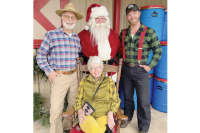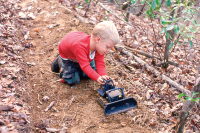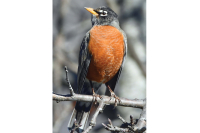Counting cars: Smokies updates decades-old visitation estimator
 NPS photo
NPS photo
Anybody who’s been to the Great Smoky Mountains National Park in the last few years has seen it — overflowing parking lots, mobbed trails and narrow mountain roads lined with cars. They’re visual symptoms of a national park bursting at the seams with unprecedented levels of visitation, hitting a highwater mark in 2021 at 14.1 million visits.
But where does that number come from? The Smokies doesn’t charge an entrance fee, so visitors don’t funnel through official entrance stations for a headcount. Instead, the park relies on automated vehicle counters and person-per-vehicle estimates.
“We’re different than Yellowstone and different than many parks with entrance stations, but in reality, all Park Service units are responsible for quantifying their visitation as accurately as possible,” said Kendra Staub, management and program analyst for the park. “Because most visitors arrive by a private passenger vehicle, it makes sense for us to develop our visitor counts from traffic counts.”
From vehicles to visitors
Of the 22 park entrances, all save the remote Twentymile entrance are outfitted with an inductive loop traffic counter that keeps track of how many vehicles drive over it.
Each month, Smokies staff retrieve data from the counters and use it to calculate visitation . Sometimes counters break or glitch — when this happens, the park substitutes the vehicle count for the same month in the previous year.
The first step to calculating visitation is subtracting a set number of vehicles from the total to account for “non-reportable” vehicles like NPS staff and volunteers and then reduce the count by 12% to avoid double-counting visitors who re-enter multiple times in a given day. Visitation at Twentymile comes from a set monthly vehicle estimate — the park has been using the same numbers since 2012.
Related Items
The park determines its final recreation visitor count by multiplying the remaining vehicle tally by a persons-per-vehicle estimate — 2.5 for the months of October through May and 2.8 for June through September. Those figures are vitally important to producing the statistics that the park uses to make myriad management and budgetary decisions.
They’re also extremely old.
“We had been using the same persons-per-vehicle multipliers since the 1980s,” said Staub.
The park has received funding from the NPS Social Science Program to update those multipliers for the first time in four decades.
In 2023, it expects to implement new person-per-vehicle estimates for its three busiest entrances — Gatlinburg, Townsend and Oconaluftee. Together, these entrances make up more than 60% of park visitation.
“You can imagine that even a small change in a number like that can have a big impact on visitation,” Staub said. “So it’ll be very interesting to see the data we get back.”

The final multipliers will be the result of two studies that Smokies staff and volunteers have carried out over the past year.
The first component focuses directly on the persons-per-vehicle question. The park trained volunteers to stand near the counters at the Oconaluftee, Gatlinburg and Townsend entrances, observing the cars passing by and noting how many occupants each held. The NPS Social Science Program provided a study schedule to ensure that data were collected during a representative sampling of time periods, including various seasons, times and days of the week, over a 12-month period. It’s an involved task, and Staub is grateful to the volunteers who made it possible for the park to complete.
“This work isn’t something that’s glamorous or glitzy, but it really helps the park,” she said.
The study wrapped up last fall, and the Smokies sent its data back to the Social Science Program, which will use it to produce a multiplier or set of multipliers that estimate actual visitation.
Before the program can complete that process, it needs data from the second component of the effort — a visitor survey. The last such survey was completed in 2008, and Staub is excited to learn more about the demographics, length of stay and activities of park visitors. The results will have implications far beyond the persons-per-vehicle multiplier, but they will also help refine that multiplier by providing information about how many times park visitors typically come and go from the park in a day. The Park Service will use that information to help filter out repeat visits from its formula.
While a person who hikes a trail, spends the night in Gatlinburg or Cherokee, and returns to the park the next day will continue to be counted as two visits, the park doesn’t want to double-count someone who, for example, walks the Oconaluftee River Trail in the morning, leaves for lunch in Cherokee, and returns for a different park activity that same afternoon.
Once the numbers for Oconaluftee, Gatlinburg and Townsend are done, the park will proceed updating multipliers for its remaining 19 entrances.
“Perhaps by the time we have PPVs (persons per vehicle) for all of them, we’re coming right back and we’re doing it again,” said Staub.
The park does not intend to wait another 40 years to re-examine its multipliers.

- Backpackers hike amid spring blooms. NPS photo
Multiplier downshift likely
With millions of cars entering the park each year, even a slight tweak to the multiplier could have significant effects. However, Smokies Management Assistant Dana Soehn said that, based on conversations with people in the national office that compiles the statistics, it’s unlikely the new multiplier will severely alter visitation numbers.
“I don’t anticipate that our visitation numbers are going to be dramatically affected by the tweaks that we make in those estimators, and that’s kind of what they find nationally whenever they update the numbers,” she said. “It generally gets tweaked a little bit, but there’s no dramatic, drastic changes.”
That said, the United States has seen significant demographic shifts since the 1980s. For example, in 1980, the average U.S. household contained 2.76 people, shifting down to 2.69 by 1985. The 2020 census put that figure significantly lower, at 2.53 people.
Additionally, some of the Smokies’ most dramatic visitation increases come from months previously thought of as off-season or shoulder season — January, February, March, November and December.
“I’m assuming that’s not your typical family vacation months,” said Soehn. “So that’s maybe retirees or more local youth, but it’s probably not your big family group. It’ll be interesting to see, because we’ve had so much growth in those months, if that affects those estimators.”
It’s likely the new multipliers will come in below the current figures, she said. However, “while our estimators may be old based on the counting processes, they’re probably not that far off.”
High-pressure statistics
Updating the multiplier is arguably more important now than it’s ever been before, with people flocking to public lands in unprecedented numbers following the arrival of COVID-19. Recreation managers across the country are working to understand who these new visitors are, what they’re expecting from their public lands, and what they need to ensure a safe and enjoyable visit.
In the Smokies, pandemic visitation has strained park resources like never before. About 60% of the country’s population lives within 800 miles of the park, making it an attractive destination for those seeking a socially distanced vacation that doesn’t require air travel. October 2020, for example, saw a 23.6% increase in visitation over October 2019. The figure for 2021 was lower than that but still 16% higher than the 2019 number.
That reality prompted the park to issue a controversial proposal that, if approved, would require a paid permit to park anywhere in the Smokies. The park’s skyrocketing visitation numbers were a significant part of the park’s justification for the proposal. If enacted, park officials said, the fee will provide an ongoing source of funding that will rise or fall in tandem with visitation. A decision is forthcoming by Oct. 1 at the latest.
However, said Soehn, visitation numbers are only part of the challenge facing the park.
“Even if we went back to 2010 visitation,” she said, “The fact is our appropriated budget is today still about the same as it was a decade ago, and the buying power of those dollars is simply far less.”
Smokies visitation backs off 2021 highs
With five months of data in for 2022, visitation is coming in significantly lower than the record-smashing figures that brought 2021’s visitation count to 14.1 million.
As of the end of May, the park had logged 4.07 million visits for 2022, down from 4.49 million at the same point last year — a 9.5% decrease. Except for February, no month in 2022 thus far has equaled or eclipsed visitation numbers posted in 2021, which for January through May were all-time records.
However, Smokies Management Assistant Dana Soehn said that doesn’t mean numbers are falling back to levels that the park considers manageable.
“If you look at it more broadly, those are still record-breaking months,” she said.
February 2022 was the highest on record, and totals for March, April and May were the second highest, beat out only by 2021. January was the fourth highest.
So far in 2022, Big Creek is seeing the largest reduction in visitation of any entrance, with totals 40.2% lower than this time last year. This could be partially attributable to visitors avoiding traffic delays associated with the bridge replacement project on Interstate 40, from which Big Creek is accessed.
Abrams Creek is the only one of the 22 entrances to see a visitation increase for 2022, with the 9,949 visits recorded representing a 12.7% increase over 2022 figures.
“When you think about the park’s visitation over time, you’ll find that while there is an overall increasing trend, there are periods of visitation declines from year to year and even month to month,” said Soehn. “The year-to-year visitation fluctuations are generally reflective of regional tourism trends that can be influenced by external factors, like gas prices or economic downturns.”













